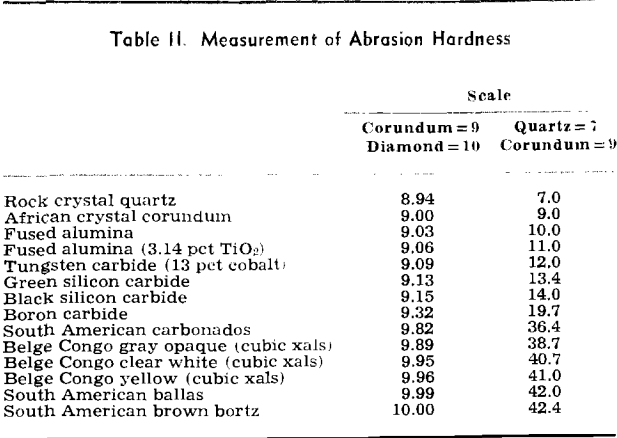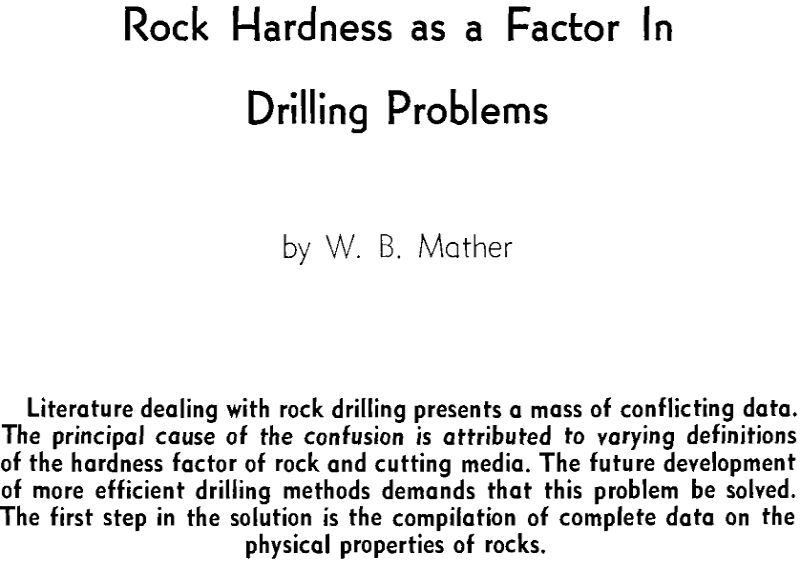A survey of the technical literature concerned with oil well drilling methods and particularly with rate of penetration by various cutting media on different types of rock provides a mass of conflicting data. This is especially true with respect to, (1) the relative efficiency of diamond, rotary and percussion drilling operations; (2) the costs of the various types of drilling; and (3) the hardness factor of various types of rock and cutting media. The latter is the particular phase of the subject discussed here.
The hardness of a mineral is defined by Dana as “the resistance which a smooth surface offers to abrasion.” Webster states that hardness is “the cohesion of the particles on the surface of a body (as a mineral) as determined by its capacity to scratch another or be itself scratched.”
The word hardness as used by the drilling fraternity has a variety of meanings which depend upon the type of drilling method employed. For example, in diamond drilling, hardness is interpretated as resistance to abrasion. In percussion drilling the term implies resistance to impact or indentation, while in rotary drilling, hardness is considered analagous to compressive strength. The three types of hardness—abrasion, impact and compression—are conflicting variables for different types of rock. Nevertheless, the term hardness is applied indiscriminately by the industry for the resistance of rock to penetration by any type of drilling technique.
Abrasion Hardness
Since 1818, Moh’s scale of hardness, although only relative in nature, has been accepted universally as the method of measuring mineral and therefore rock hardness.
In 1935, Wooddell measured the relative resistance of minerals to abrasion during lapping and proposed further refinements to Moh’s scale in an effort to reduce the relative character of the scale and provide a numerical hardness value more in keeping with the comparative resistance to abrasion of the various minerals.
In other words, the hardness ratio of South American brown bortz and quartz is 6:1 instead of 10:7 as one would infer from the old Moh’s scale. The low tensile strength of diamonds permits their use only in diamond drilling where the load on the bit is relatively small and impact is reduced to a minimum. However, in the case of silicon carbide and fused alumina, which also have low tensile strengths, their lower hardness values does not permit their economical use in the facing of drill bits. After diamonds, boron carbide is the hardest mineral substance, and although it is very resistant to abrasion, its low tensile strength prevents its use as a cutting medium.
In diamond drilling operations in Crane County, Texas, McCray reports, “As different strata of limestone drill at widely different rates, varying from perhaps 6 or 8 to 90 minutes per foot, and as sandstones generally core at rates from 5 to 10 minutes per foot, much faster on the average than limestones or dolomites, it must be concluded that hardness is not a factor of the rate of penetration.”


In Southwest Research Institute drilling experiments using tungsten carbide, alundum and carborundum as cutting media, it was observed that fine-grained Austin chalk was penetrated much more rapidly than coarser grained Edwards limestone. This fact is explained partially by the greater degree of cementation in Edwards limestone than in the Austin chalk in spite of the fact that chemical or mineralogical analyses would show that both rocks had nearly identical compositions.
In the case of diamond drilling or in similar methods of rock penetration where abrasion is believed to be the governing factor, there are other variables which cloud the picture. For example, there is the contention that finer grained rocks are more difficult to penetrate than coarser grained rocks of identical mineral composition, where the only apparent difference in these two rocks is that the finer grained type contains more grain boundaries than the other, the inference being that grain boundaries exhibit a greater resistance to abrasion than the interior of the grain.

